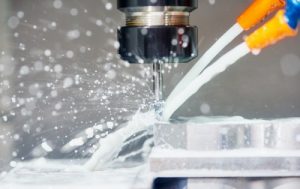
Bacteria In Metalworking Fluids
Share
The Health and Safety Executive (HSE) emphasizes the importance of monitoring and controlling bacteria levels in metalworking cutting fluids. Alongside bacteria levels, checks on fluid quality, such as pH levels and fluid concentration, should also be performed regularly to maintain system efficiency and safety.
Importance of Risk Assessment
A robust risk assessment must address how bacterial contamination is monitored and controlled within your systems. The HSE recommends conducting dipslide tests at regular intervals, typically on a weekly basis, to measure bacterial growth effectively. Dipslides are a straightforward and efficient method to ensure compliance and maintain system hygiene.
Impact of Bacterial Contamination
Uncontrolled bacterial contamination can lead to:
- Decreased quality of metalworking fluids.
- Increased health risks for employees and users exposed to the contaminated fluids.
Proper monitoring and regular testing are essential to mitigate these risks and ensure a safe working environment.
Controlling the Risk to Employee Health from Metalworking Fluids
Proper monitoring and maintenance of metalworking fluids are essential to protect the health of employees. Degraded or contaminated cutting fluids can pose significant health risks, including respiratory and skin-related conditions.
Key Health Risks Associated with Contaminated Fluids
When cutting fluids degrade or become highly contaminated, they can lead to serious health problems:
-
Respiratory Issues: The spray and mist produced by machines can be inhaled, potentially causing:
- Respiratory Infections
- Occupational Asthma
- Bronchitis
- Extrinsic Allergic Alveolitis (EAA)
-
Skin Conditions: Prolonged exposure can result in:
- Dermatitis
- Skin Irritation
Maintaining a Safe Work Environment
To ensure a healthy environment for workers:
- Regularly inspect and maintain cutting fluids to minimize contamination.
- Implement measures to reduce spray and mist in the workspace.
- Monitor employees for any symptoms of work-related health issues.
Common Bacteria Found in Metalworking Fluids
-
Pseudomonas
- Characteristics: The most prevalent bacteria in metalworking fluids.
- Health Risks: Can cause serious infections, particularly in individuals with weakened immune systems, and may affect the respiratory tract.
- Industrial Impact: Frequently found in facilities using metalworking machinery
-
Mycobacterium
- Characteristics: Another common bacteria in metalworking fluids.
-
Health Risks: Linked to Hypersensitivity Pneumonitis (HP), a lung inflammation condition.
- Symptoms: Dry cough, muscle and joint pain, fever, and fatigue.
- Concerns: Prolonged exposure can exacerbate respiratory issues.
Workplace Risk and Disease Prevention
Metalworking fluid-related diseases can easily occur in the workplace if proper precautions are not taken. Employers must:
- Be aware of potential health risks posed by bacteria in metalworking fluids.
- Implement control measures to protect employees and maintain a healthy work environment.
Compliance and Testing Solutions
To adhere to COSHH (Control of Substances Hazardous to Health) regulations:
- The HSE recommends dipslide testing to monitor bacteria, fungi, and other contaminants in metalworking fluids.
- Dipslides: A simple and effective method for identifying microbial contamination and ensuring compliance with safety guidelines.
By prioritizing regular testing and management, businesses can reduce risks and maintain safety standards.
Contamination of Bacteria in Metalworking Fluids
It is essential to continuously monitor water mixes within a pipe system to ensure they remain uncontaminated. Bacteria can multiply rapidly in water mixes, becoming harmful in a short period if left unchecked. Regular observation is critical to prevent issues from going undetected.
Certain semi-synthetic fluids tend to be more sterile than non-synthetic counterparts, offering a better defense against bacterial contamination. These fluids can play a key role in preventing water pollution and maintaining system integrity.
Monitoring and proactive maintenance are the best ways to safeguard your systems and ensure compliance with health and safety standards.
What Is A Dipslide and how can it help treat Bacteria in Metalworking Fluids?
The most common way to measure and monitor microbial activity is the use of dipslides. The HSE recommends using dipslides to monitor the general activity of aerobic bacteria.
A dipslide is a sterile culture medium used to dip into the liquid to test the levels of bacteria. The dipslides are then incubated for typically 48 hours at 30 degrees Celsius to allow for any microbial growth. A reference chart is then used to compare the results and trend activity over time.
Each dipslide is dual sided, and each type of agar tests for a different group of micro-organisms.
Why Use Cutting Fluid Dipslides?
Our cutting fluid dipslides are designed specifically to test for:
- Total bacteria count
-
Yeasts, moulds, and fungi
These align with the recommendations set by the Health and Safety Executive (HSE) for proper fluid testing.
Key Features of CF Dipslides
-
Packaging:
- Supplied in boxes of 10, with each dipslide being single-use for convenience and hygiene.
-
Dual-Sided Design:
- Side 1: Nutrient agar with TTC for total bacteria count.
- Side 2: Malt extract agar for detecting moulds, yeasts, and fungi.
-
Ease of Use:
- Flexible handles ensure easy grip and handling.
-
Guidance and Record Keeping:
- Includes a leaflet with instructions for care, storage, and usage.
- Comes with a visual comparison chart for interpreting results.
- Contains 10 adhesive labels for recording sample details (date, time, and source).
-
Shelf-Life:
- Long-lasting dipslides with a shelf-life of 6 months or more when stored correctly.
Ideal Applications
These dipslides are perfect for testing metalworking and cutting fluids, ensuring compliance with legal and safety recommendations. By choosing our CF Dipslides, you can effectively monitor and maintain the safety and quality of your systems.
Can I Speak to Someone About the Right Dipslides?
Absolutely! Our team of dedicated and experienced staff is here to provide guidance on selecting the right type of dipslides to suit your specific needs. Whether you prefer to chat, call, or email us, we’re happy to help. Please refer to the contact details at the top of this page to reach us.
